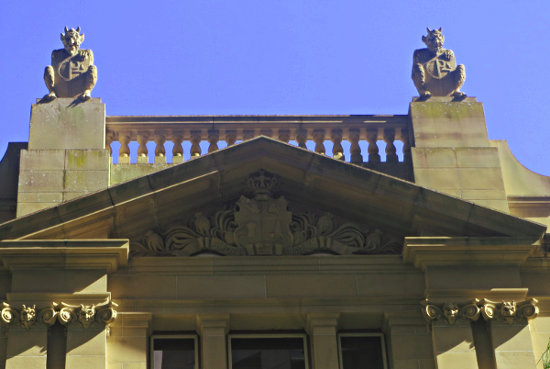As you wander the streets of Brisbane’s CBD, you may get the feeling you’re being watched.
If it’s not the “Big Brother” presence of security cameras raising hairs on the back of your neck, it could be the city’s resident population of gargoyles and grotesques, peering down from the eaves and rooves of historic buildings.
Halfway along George Street, you’ll find the former Government Printing Office which was built in 1910. On the keystone above the door is a leering devil. Two more are perched along the parapet, holding the type-face letters G & P (for Government and Printers). The devil was once considered the patron of the printing profession. One theory is that young apprentices slaving over presses would be covered in black ink by day’s end – leading to their nickname “printer’s devils” and the term “the black arts”.
Further up George Street, heading towards Parliament House, you’ll discover The Mansions. Look closely to find a pair of proud cats sitting on the upper corners. The terrace houses were built as an investment in 1889 by a consortium of Queensland politicians, including the then Premier. One theory is that the stone felines were added as a tongue-in-cheek nod to the building’s “fat cat” owners.
Over in Queen Street, next to the GPO, you’ll find more stone sentinels keeping an eye on passers-by. The Manor Apartments are the former headquarters of the Colonial Mutual Life Assurance Society. Populating the exterior is a menagerie of stone creatures – including owls and lions. Human faces also peer from the facade – each said to be the likeness of a former CML director.
The University of Queensland at St Lucia might well be dubbed “grotesques central”. The cloisters of the Great Court are home to 49 stone caricatures of academics, tradesmen and other people with close ties to campus life.
Prominent Brisbane sculptor, Rhyl Hinwood, is responsible for crafting 17 of the fantastic faces.
“Gargoyles are functional waterspouts but these are not: they’re purely decorative,” explains Rhyl. “Grotesques were probably originally carved for grottoes.”
The line-up of stone grotesques includes her own image – decorated with whimsical detail.
“I’ve depicted myself wearing a dust mask to keep the chips and dust out of my eyes. And I’ve got my finger in one ear because the angle-grinder I’m holding makes quite a lot of noise!”













